Exhaust ventilation through the wall to the street: installing the valve through an opening in the wall
Most of the new materials and prefabricated structures introduced into the construction and decoration sector almost completely exclude free air movement. The tightness provided by them along with the pluses brought a significant minus - violation of ventilation processes.
They simply need to be restored, because, you see, without a regular supply of fresh air into the room, it is impossible to live in it!
We know how to solve such a difficult problem: exhaust ventilation through the wall to the street will form the normal movement of air masses. A small wall device will provide exhaust flow and excellent air exchange.
Our proposed article will acquaint you with the intricacies of choosing a valve for organizing exhaust ventilation, with the rules for its installation and operation. The information submitted for consideration is confirmed by photo materials, diagrams and video instructions.
The content of the article:
Common ventilation problems
Natural ventilation of living quarters is based on the presence of micro-cracks characteristic of wooden window structures. Through such small openings, air regularly came in from the outside and was removed from the house through ventilation ducts arranged in the building structures.
So in the apartment there was a constant change of air masses, contributing to a normal level of humidity, removing unpleasant odors, etc.

Improper air exchange in the house is a practically unavoidable problem when taking measures to reduce heat loss. When installing new windows and doors, trying to minimize heat leakage, few people think about ventilating their homes.
But soon the problems appear in the form of a stuffy atmosphere, the growth of mold in the bathroom and other similar phenomena. Soon, the abnormal microclimate begins to negatively affect the health status of those who live in such a house.
Ventilating supply units various types and types help to deal with excessive sealing of rooms, but for normal ventilation this may not be enough.
The draft of natural exhaust ventilation is often weak, if not completely missing. Due to problems with the installation of ventilation structures, part of the air masses that must be removed from the house penetrates back.
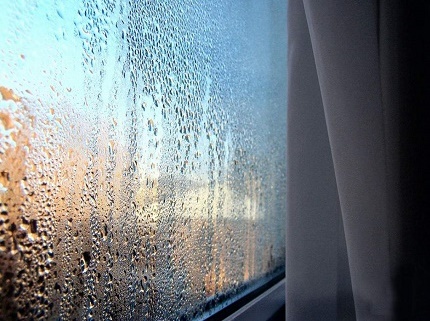
On the state of draft in the ventilation system of the house or apartments the air temperature is also reflected in the street, or rather, the temperature difference indoors and outdoors.
In winter, this gap is large enough to provide good traction. But in the summer, the temperature difference between the external and internal air is not so significant, and this affects the quality of traction is not too good.
For these reasons, you should think about the need to install special exhaust valves. They will ensure quick and effective removal of exhaust air from the home, as well as prevent its back penetration.
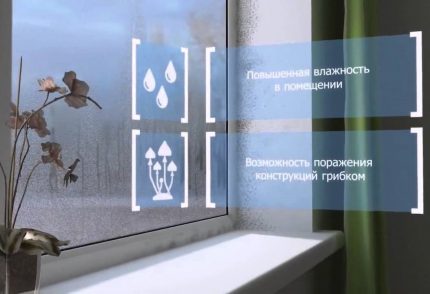
Varieties of exhaust valves
The low efficiency of exhaust ventilation is most often due to various reasons, for example, a violation of the patency of the channels or their tightness.
In multi-storey buildings, such situations often arise due to flaws in the repair process, and eliminate consequences errors and restore the normal condition of the ventilation ducts is not always possible.

In this case, the exhaust valves may be more than appropriate. The design of these devices is very simple, their main purpose is to let air flow out and not allow them to penetrate back. By the type of installation, such valves are divided into horizontal and vertical, it all depends on the direction of air flow.
If the exhaust flow should move vertically, choose a valve with horizontal installation. And to divert air horizontally, you need a vertical valve. Typically, exhaust valve models are equipped fan. They are used where the removal of air from the premises must be carried out forcibly.
Another significant point is the noise level that a working device emits. The lower the sound effects from the expanding blades of the valve and / or the rotary fan, the better. A lot of useful information can be found in the product data sheet.
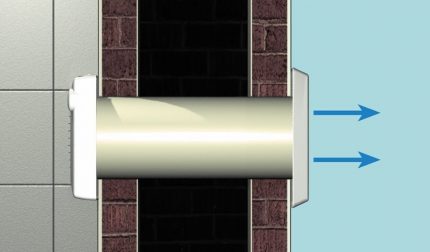
Wall device design
A conventional exhaust valve consists of three main parts:
- flange;
- flaps;
- decorative lattice.
The round flange is a connecting element that allows you to connect the valve to the ventilation duct. The grill is a decorative element that simply disguises a hole in the wall and also prevents accidental ingress of large debris. The basis of the design is a damper.
This is a movable petal, round or square configuration, mounted on an axis. It can open only in one direction, ensuring the correct movement of the air flow. The design may also include a plumb line, which allows the valve to remain closed when the fan is turned off.
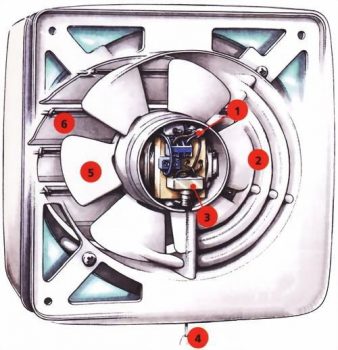
For industrial facilities, it is usually recommended to select a valve with good explosion-proof characteristics, but for residential premises other features are important. For example, having a rubber gasket that can reduce the amount of noise will be useful.
One common exhaust valve option is a butterfly design. It consists of two blades mounted on a central axis. Another popular design of such devices is called flap, it includes a number of parallel mounted blades that move on the principle of blinds.
The installation of an axial fan for the exhaust type of ventilation is carried out according to a single scheme for all systems:
Such a fan is often mounted in bathrooms, the bathrooms.
Reasonable choice
Most often, the exhaust ventilation valves in the wall are made of metal or durable plastic. For conditions of elevated temperature and humidity, for example, for a bath, plastic products are not suitable, but they have proven themselves in less difficult situations.
When choosing a valve, its cross-section should be taken into account: rectangular or round.
The most important indicator is the air flow rate for which the device is designed. The most common are models designed for a flow of 4-6 m / s.
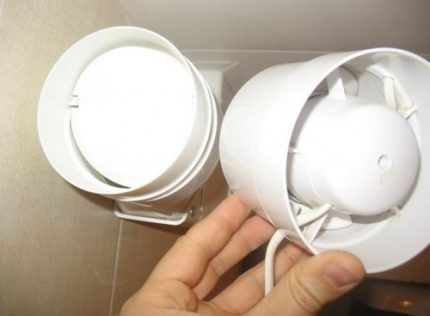
If the valve is selected for the natural ventilation system, it is very important that the valve flap elements are sensitive to even small air flows. But for systems with weak traction, the presence of an exhaust fan is necessary, therefore, such sensitivity is not needed.
But here it is important to choose a fan that is suitable for power depending on the volume of the room for which the device is selected.So, for the kitchen, the fan power is calculated using a raising factor equal to ten, and for the bathroom this figure can be seven units.
In multi-storey buildings, the exhaust ventilation pipe must be led out one meter above the roof so that unpleasant odors do not penetrate from the lower floors to the upper ones.
Subtleties of the construction of exhaust ventilation in the wall
In private homes and even in multi-story buildings, in many cases it is more convenient to make a ventilation outlet directly through the wall. To do this, models of exhaust valves with a fan are used, which are inserted into the mounting sleeve intended for their location.
You can also use overhead models of fans that are mounted on the inside of the wall.

To install such a simple design, you will need to make a sufficiently large hole for the installation of ventilation in the outer wall of the house. But first you need to choose the right device.
Manual models have a reasonable price, but they are extremely inconvenient to operate, because you will constantly have to remember the need to turn the exhaust valve on or off.

To automate the process, you can use a timer. It will be necessary to select a time schedule, in accordance with these settings, the valve will turn on and off at the specified time. More effective may be the use of a sensor that responds to humidity in the room.
In this case, the device will begin to work when the air in the room becomes too humid, and when the humidity decreases, the fan stops. When choosing automatic control devices, you should make sure that when the power is turned off, the previously set settings are saved.
To ensure good air exchange in the room, it is necessary to use a sufficiently powerful fan. A weak unit in this regard simply cannot cope with the movement of a large volume of air masses; as a result, ventilation will not be effective enough.
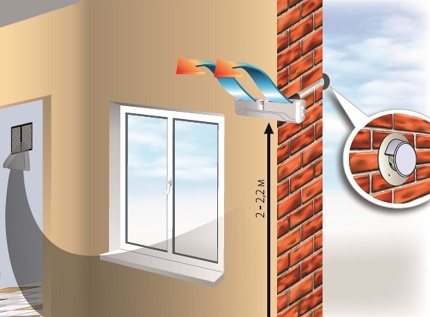
In calculations, they usually use a simple formula:
M = O * B
Where:
- M - required fan power;
- О - volume of the room in which the device will be installed;
- In - increasing the coefficient of air exchange.
It is possible to calculate the volume of a room from a school course in mathematics as a product of the area and height of the room. The air exchange coefficient is determined depending on the purpose of the room.
This indicator should be:
- for a separate toilet - 8;
- for the kitchen - 15;
- for a bathroom or a combined bathroom - 20.
It remains only to determine the volume of the room and multiply it by the appropriate coefficient to get an indicator that will help you choose a valve with a sufficiently powerful fan. Do not take an excessively powerful model, it will only cause unnecessary costs and will not affect the ventilation process favorably.
When calculating the power of the exhaust fan, it is necessary to take into account the sensitivity of such equipment to the resistance of the system. The presence of a decorative grille and valve can reduce the speed of air flow by three to five or even ten times. Therefore, do not choose a device with a minimum size and power.
Fan performance should be sufficient to allow exhaust air to flow through the valve from adjacent rooms, and not just from the room in which the device is installed.Before starting work on installing an exhaust valve with a fan, you must select a suitable location.
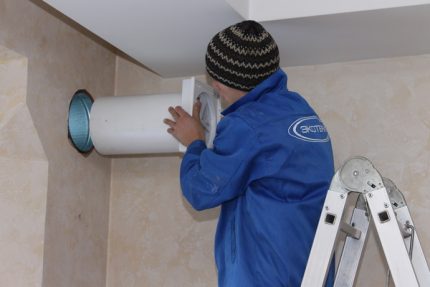
To do this, use a wall that is as far as possible from the place where fresh air is taken. Typically, ventilation is installed in the walls or windows of rooms such as a bedroom or living room.
For exhaust ventilation, a kitchen or a bathroom. As a result, unpleasant odors, excess water vapor, etc. are also discharged with the exhaust air.
A hole for the exhaust valve must be made at the top of the wall. First, marking is performed, then drilling begins. A suitable hole is made with a drill and a core drill. Sometimes you have to use a special tool with a diamond nozzle.
The hole for the exhaust valve must be the same size and configuration as the fan. This is usually a round device, but sometimes it is more convenient to use a device with a square case. In this case, the hole for the valve must be hollowed out using a hammer drill with a nozzle in the form of a scapula.
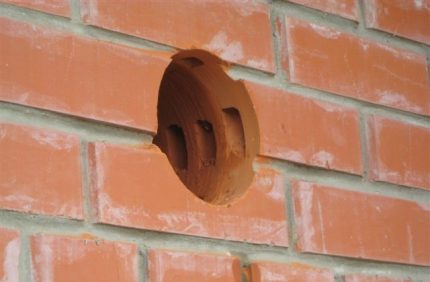
Such work is usually accompanied by a large amount of dust, from which even the use of an industrial vacuum cleaner does not save. Before drilling, cover surfaces with a film or other suitable materials to protect them from contamination.
A core drilling machine can be used to drill particularly thick exterior walls of durable materials. This is expensive equipment that is cheaper to rent than to buy. Specialized firms provide core drilling services at a relatively low price, which depends on the drilling depth and wall material.
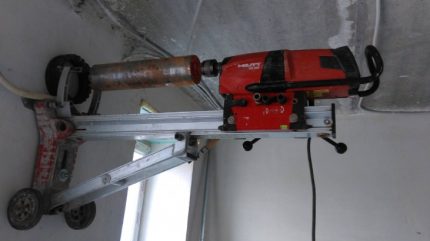
During operation of this equipment water cooling is used. At the same time, a device is used to collect waste material and water, but part of it will still hit the wall, this point should be taken into account before starting work.
After the hole has been prepared and cleaned of dust, a sleeve must be inserted into it, it is supplied with the valve.
Now you need to mark the mounting points of the fan. The device is fixed to the wall through the holes provided for this. As fasteners, dowels-spacers are most often used. Usually between the coupling and the wall there is a small gap through which air can subsequently penetrate.
All such cracks are gently blown with foam, which will provide the construction with the necessary tightness. After that, you can start installing the exhaust valve. Proceed very carefully so as not to damage the valve itself during installation and to prevent construction debris from entering it.
After installation, make sure that the valve flaps move freely, do not jam. After that, on the outside of the wall of the house you need to install a decorative grille that will close the hole and give the design an aesthetic appearance.
To improve the efficiency of the exhaust valve and reduce the likelihood of freezing in the winter, it is recommended to lay a layer of insulating material around the coupling. This point must be taken into account when calculating the diameter of the hole for the exhaust valve.
Some masters consider the coupling, which is equipped with an exhaust valve, not strong enough.They note that if necessary, the coupling may be accidentally damaged, and recommend replacing it with a piece of a stronger plastic pipe of the appropriate diameter.
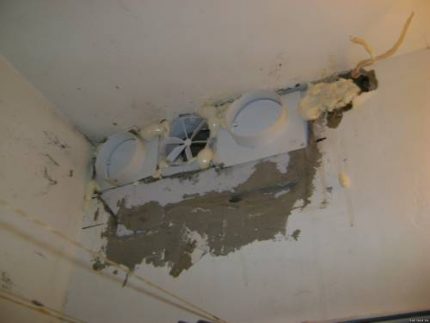
If such a pipe turns out to be slightly wider than the fan that is inserted into it, it is possible to rewind it with electrical tape or other suitable material so that the device enters sufficiently tightly.
The fan should be supplied with power from the inside. The cable is led to the electrical panel, when connecting for safety reasons, use fusible fuses.
When installing the exhaust valve in the toilet, bathroom, the power supply can be connected so that the fan turns on simultaneously with lighting. In this case, the timer can be set to turn off after a certain period after the light is turned off.
In order for exhaust ventilation in the toilet and the bathroom to work effectively, an air flow into these rooms should be ensured. Usually, special ventilation grilles are installed at the bottom of the doors for this.
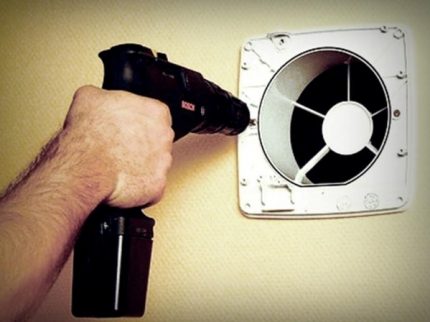
During operation, the exhaust valve should be considered a problem such as the occurrence of blockages. If debris enters the device, it may break the valve and make the fan difficult.
If this happens, the device will have to be dismantled, cleaned of impurities and installed again. Butterfly valves in winter can be covered with a layer of ice, which also leads to problems in the operation of the mechanism.
Conclusions and useful video on the topic
The process of installing the fan and the check valve through the wall is described in detail in this video:
The operation of a high-power exhaust fan with a non-return valve is demonstrated here. The device is characterized by increased strength and low noise during operation:
Exhaust ventilation is a necessary element for normal air exchange in the house. If it is installed correctly, then normal humidity and a favorable microclimate will be maintained in the living quarters.
Have experience in installing a wall ventilation duct? Or have questions about the topic? Please share your opinion and leave comments. The feedback form is located below.

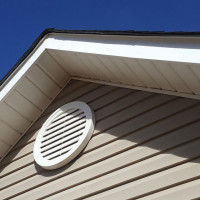 Ventilation in a private house through the pediment: arrangement options
Ventilation in a private house through the pediment: arrangement options 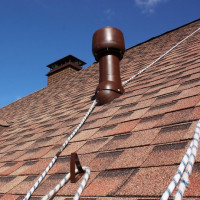 Ventilation on the roof of a private house: the construction of the passage of the duct through the roof
Ventilation on the roof of a private house: the construction of the passage of the duct through the roof 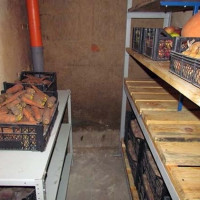 Do-it-yourself ventilation of the cellar in the garage: installation methods and procedures + useful tips for arranging
Do-it-yourself ventilation of the cellar in the garage: installation methods and procedures + useful tips for arranging 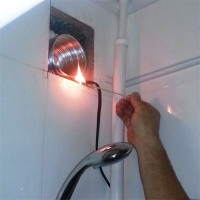 Return draft in ventilation of a private house: why ventilation works in the opposite direction and how to eliminate it
Return draft in ventilation of a private house: why ventilation works in the opposite direction and how to eliminate it 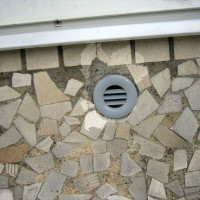 How to install a supply valve into the wall with your own hands: step-by-step instructions for the work
How to install a supply valve into the wall with your own hands: step-by-step instructions for the work 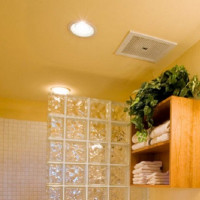 Ventilation in the bathroom in the ceiling: arrangement features + installation instructions for the fan
Ventilation in the bathroom in the ceiling: arrangement features + installation instructions for the fan  How much does it cost to connect gas to a private house: the price of organizing gas supply
How much does it cost to connect gas to a private house: the price of organizing gas supply  The best washing machines with dryer: model rating and customer tips
The best washing machines with dryer: model rating and customer tips  What is the color temperature of light and the nuances of choosing the temperature of the lamps to suit your needs
What is the color temperature of light and the nuances of choosing the temperature of the lamps to suit your needs  Replacement of a geyser in an apartment: replacement paperwork + basic norms and requirements
Replacement of a geyser in an apartment: replacement paperwork + basic norms and requirements
It seems to me that many had problems with ventilation. When using new sealed structures and insulating materials, it is necessary to install exhaust ventilation in your home, even in the country. Before doing it, it is better to study this issue yourself, of course, because not all masters responsibly and efficiently perform their work, but you can talk a lot and charge an unreasonably expensive fee. After reviewing the material, I noted a lot of important points for myself. Now I can observe the installation process already as a person competent in this matter.
Forced ventilation is especially relevant in apartment buildings.For example, ventilation in the bathroom does not work for us at all, which they just didn’t do with it. To put such an aggregate ... well, I don’t know, the noise level scares me, although it is said that they are silent. In a private house, yes, the option is not bad, but then again - what about in cold weather? They will also influence, and tightness here will not save.
Hello everyone! Guys, please tell me!
I have a private house. He made an extension from the Poritep foam block and made a combined bathroom in it. So I want to make exhaust ventilation through the wall. The question is, is it necessary to install the pipe at an angle with a slope to the street (so that condensate flows down the street) or can it be horizontally? Is it necessary to insulate the pipe, if so, what is better? I was told there is a foam tubular insulation. Will it fit or is there an alternative?
And another question is a little off topic, but I think there are experts here. Draft ceiling in the bathroom from the board. Do I need to put steam or waterproofing on it? In the future, the ceiling will be underestimated by 10-15 centimeters and made of panels!
And the last question - is it necessary to ventilate this gap? If so, how? To whom it is not difficult, draw everything schematically with explanations! Thank you all in advance!
The pipe, especially the part that will pass through the wall, must be insulated. The material that you are recommended is ideal for this. Mount the channel horizontally, no need to make a large slope, not more than 1-2 degrees. To prevent condensation and cold air to enter, use a non-return valve.
Now for the ceiling. You need to not only sheathe it with waterproofing, but also insulate it. With proper installation, you do not have to make any additional technical holes.
The ventilation project must be thought out to the smallest detail and everything must be calculated correctly so that there is no increased humidity in the bathroom, because of which mold will form. It makes no sense to draw a diagram, since I do not have accurate data on the object in question.
It remains to find out the main question: where is the permission from the specialized services responsible for the technical condition of the apartment buildings? Or can anyone drill external walls where and how he wants?
I sent a comment, the scoreboard was displayed: "Your comment is awaiting verification." What kind of check is this? For loyalty to the government, or something ...
Hello! Regarding the verification of comments: the site is pre-moderated, so you have to wait a few hours for the moderator to check the comment, after which it will be visible to all visitors to the site.
Regarding the drilling of technical holes for ventilation in the external walls: if everything is done according to the SANPIN, then you do not need to take any permissions. Naturally, the integrity of the outer wall should not be compromised. Also, do not forget to coordinate this issue with other residents. We had a case when a cafe was obliged to redo the outside of the ventilation, which the residents of the house complained about.
Alexei, the outer walls - these are the bearing walls. And they can’t always be ditched. For example, according to Appendix No. 1 to the Decree of the Government of Moscow of 10.25.2011 No. 508-PP. Item 11.12:
When performing work on the reconstruction and (or) redevelopment of residential and non-residential premises in apartment buildings, it is not allowed: [...] 11.12. The device strobes in horizontal joints and under internal wall panels, as well as in wall panels and floor slabs for the placement of electrical wiring, piping (in multi-unit type buildings).
Ventilation is a conversion. But at the same time, there is PP No. 508, which does not allow: “p. 11.4. Violation of the strength, stability of the supporting structures of the building, in which their destruction can occur. "That is, here in any case, an agreement that will doubtfully be obtained.
Similar ventilation in the kitchen with access to the balcony of the apartment on the 5th floor was established by the owner of the apartment on 4 floors. As a result, for many years, all the kitchen smells and cigarette smoke go to the apartment of 5 floors. This significantly aggravated the state of health of the tenant of the apartment on the 5th floor. He was constantly suffocating, very tormented, and died. The presence of a hood was discovered recently. The owner of the apartment on the 4th floor is a police officer.
Advice?
Hello. Tips for what? How to go to court and prove harm to health? It is unlikely that a cooker hood exacerbated the health of the employer. There is no difficulty in eliminating the illegal hood - a complaint to the Criminal Code, Rospotrebnadzor, the prosecutor's office, and so on. The fact that a person is a police officer does not give him the right to inviolability.